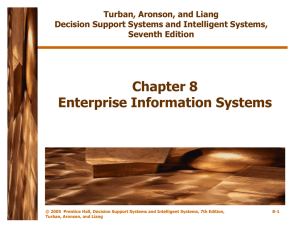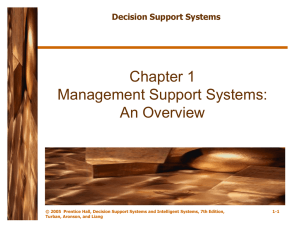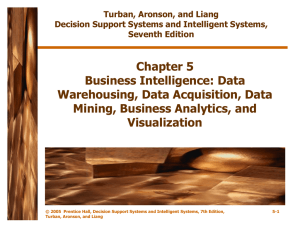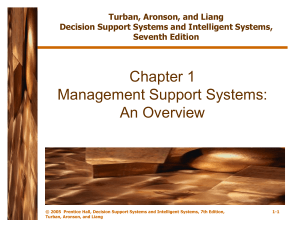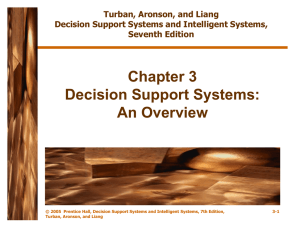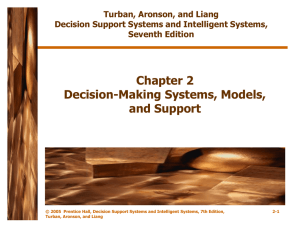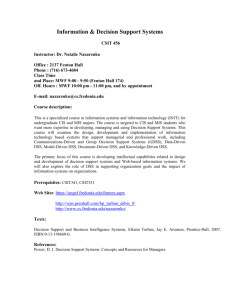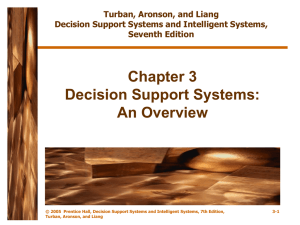Chapter 6 Decision Support System Development
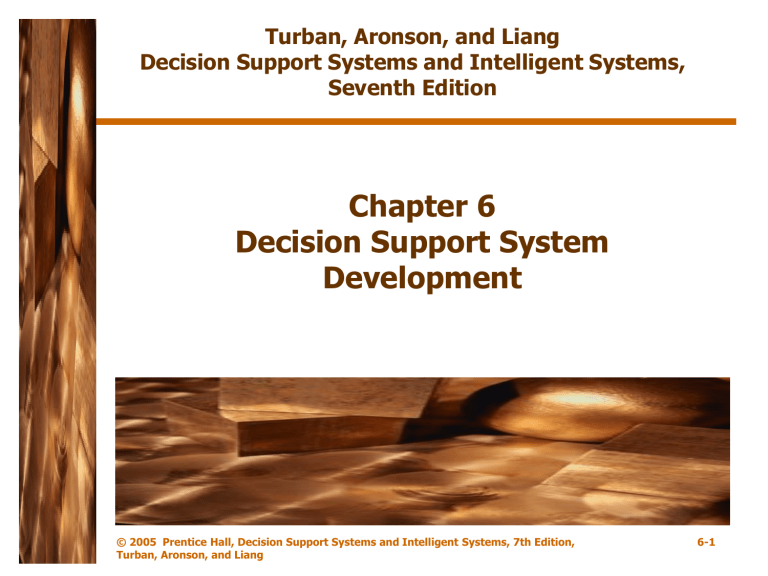
Turban, Aronson, and Liang
Decision Support Systems and Intelligent Systems,
Seventh Edition
Chapter 6
Decision Support System
Development
© 2005 Prentice Hall, Decision Support Systems and Intelligent Systems, 7th Edition,
Turban, Aronson, and Liang
6-1
Learning Objectives
• Understand the concepts of systems development.
• Learn PADI, the phases of SDLC.
• Describe prototyping.
• Understand which factors lead to DSS success or failure.
• Learn the importance of project management.
• Describe the three technology levels of DSS.
• Understand the learning process involved in DSS development.
© 2005 Prentice Hall, Decision Support Systems and Intelligent Systems, 7th Edition,
Turban, Aronson, and Liang
6-2
Osram Sylvania Thinks Small,
Strategizes Big-Develops the Infonet
HR Portal System Vignette
• Creation of a specialized business portal to solve specific problem
– Prototype
– Interactive, Web-based
– HR portal
• Think small, strategize big
– Focus on key problems first
– Plan to achieve quick small successes
• Intranet-based portal for hiring, job postings, benefits, bonuses, retirement information
© 2005 Prentice Hall, Decision Support Systems and Intelligent Systems, 7th Edition,
Turban, Aronson, and Liang
6-3
Systems Development Life Cycle
• Four phases
– Planning
– Analysis
– Design
– Implementation
• Cyclical
• Can return to other phases
• Waterfall model
© 2005 Prentice Hall, Decision Support Systems and Intelligent Systems, 7th Edition,
Turban, Aronson, and Liang
6-4
Tools
• Computer-aided software design tools
– Upper CASE –
• Creates systems diagrams
– Lower CASE
• Manages diagrams and code
– Integrated CASE
• Combination
• RAD design tools
– Enterprise class repository and collaboration
– UML modeling
• Analysis and design software
• Code debugging methods
• Testing and quality assurance tools
© 2005 Prentice Hall, Decision Support Systems and Intelligent Systems, 7th Edition,
Turban, Aronson, and Liang
6-5
Successful Project Management
• Establish a baseline
• Define scope of project
• Manage change and scope creep
• Get support from upper management
• Establish timelines, milestones, and budgets based on realistic goals
• Involve users
• Document everything
© 2005 Prentice Hall, Decision Support Systems and Intelligent Systems, 7th Edition,
Turban, Aronson, and Liang
6-6
Implementation Failures
• Lack of stakeholder involvement
• Incomplete requirements
• Scope creep
• Unrealistic expectations
• Project champion leaves
• Lack of skill or expertise
• Inadequate human resources
• New technologies
© 2005 Prentice Hall, Decision Support Systems and Intelligent Systems, 7th Edition,
Turban, Aronson, and Liang
6-7
Evolutionary Disruptors
• Development environment
– Organizational cultural factors
– Loss of top management support
– User and analyst attitude
– User experience
– Development team capability
• Development process
– User education, support, involvement, training
© 2005 Prentice Hall, Decision Support Systems and Intelligent Systems, 7th Edition,
Turban, Aronson, and Liang
6-8
Project Management Tools
• Project management software can allow:
– Collaboration among disparate teams
– Resource and program management
– Portfolio management
– Web enabled
– Aggregates and analyses project data
© 2005 Prentice Hall, Decision Support Systems and Intelligent Systems, 7th Edition,
Turban, Aronson, and Liang
6-9
Alternative Development
Methodologies
• Parallel development
– Multiple development on separate systems
• RAD
– Quick development allowing fast, but limited functionality
• Phased development
– Sequential serial development
• Prototyping
– Rapid development of portions of projects for user input and modification
– Small working model or may become functional part of final system
• Throwaway prototyping
– Pilot test or simple development platforms
© 2005 Prentice Hall, Decision Support Systems and Intelligent Systems, 7th Edition,
Turban, Aronson, and Liang
6-10
© 2005 Prentice Hall, Decision Support Systems and Intelligent Systems, 7th Edition,
Turban, Aronson, and Liang
6-11
Agile Development
• Rapid prototyping
• Used for:
– Unclear or rapidly changing requirements
– Speedy development
• Heavy user input
• Incremental delivery with short time frames
• Tend to have integration problems
© 2005 Prentice Hall, Decision Support Systems and Intelligent Systems, 7th Edition,
Turban, Aronson, and Liang
6-12
DSS Development Methodology
• Prototyping
• Iterative design
• Evolutionary development
• Middle out process
• Adaptive design
• Incremental design
© 2005 Prentice Hall, Decision Support Systems and Intelligent Systems, 7th Edition,
Turban, Aronson, and Liang
6-13
DSS Prototyping
• Short steps
– Planning
– Analysis
– Design
– Prototype
• Immediate stakeholder feedback
• Iterative
– In development of prototype
– Within the system in general
– Evaluation integral part
• Control mechanism
© 2005 Prentice Hall, Decision Support Systems and Intelligent Systems, 7th Edition,
Turban, Aronson, and Liang
6-14
DSS Prototyping
• Advantages
– User and management involvement
– Learning explicitly integrated
– Prototyping bypasses information requirement
– Short intervals between iterations
– Low cost
– Improved user understanding of system
• Disadvantages
– Changing requirements
– May not have thorough understanding of benefits and costs
– Poorly tested
– Dependencies, security, and safety may be ignored
– High uncertainty
– Problem may get lost
– Reduction in quality
– Higher costs due to multiple productions
© 2005 Prentice Hall, Decision Support Systems and Intelligent Systems, 7th Edition,
Turban, Aronson, and Liang
6-15
Change Management
• Crucial to DSS
• People resistant to change
• Examine cause of change
• May require organizational culture shift
• Lewin-Schein change theory steps
– Unfreeze
• Create awareness of need for change
• People support what they help create
– Move
• Develop new methods and behaviors
• Create and maintain momentum
– Refreeze
• Reinforce desired changes
• Establish stable environment
© 2005 Prentice Hall, Decision Support Systems and Intelligent Systems, 7th Edition,
Turban, Aronson, and Liang
6-16
DSS Technology Levels
• DSS primary tools
– Fundamental elements
• Programming languages, graphics, editors, query systems
• DSS generator (engine)
– Integrated software package for building specific DSS
• Modeling, report generation, graphics, risk analysis
• Specific DSS
– DSS application that accomplishes the work
• DSS primary tools are used to construct integrated tools that are used to construct specific tools
© 2005 Prentice Hall, Decision Support Systems and Intelligent Systems, 7th Edition,
Turban, Aronson, and Liang
6-17
© 2005 Prentice Hall, Decision Support Systems and Intelligent Systems, 7th Edition,
Turban, Aronson, and Liang
6-18
DSS
• Hardware
– PCs to multiprocessor mainframes
• Software
– Involves multiple criteria
– Develop in house, outsource, or buy off the shelf
– Off the shelf software rapidly updated; many on market
– Prices fluctuate
– Different tools available
© 2005 Prentice Hall, Decision Support Systems and Intelligent Systems, 7th Edition,
Turban, Aronson, and Liang
6-19
DSS
• Team developed DSS requires substantial effort to build and manage
• End user developed DSS
– Decision-makers and knowledge workers develop to solve problems or enhance productivity
• Advantages
– Short delivery time
– User requirements specifications are eliminated
– Reduced implementation problems
– Low costs
• Risks
– Quality may be low
– May have lack of documentation
– Security risks may increase
© 2005 Prentice Hall, Decision Support Systems and Intelligent Systems, 7th Edition,
Turban, Aronson, and Liang
6-20
DSS
• DSS is much more than just a DBMS,
MBMS, GUI, interface, and knowledge component
© 2005 Prentice Hall, Decision Support Systems and Intelligent Systems, 7th Edition,
Turban, Aronson, and Liang
6-21

